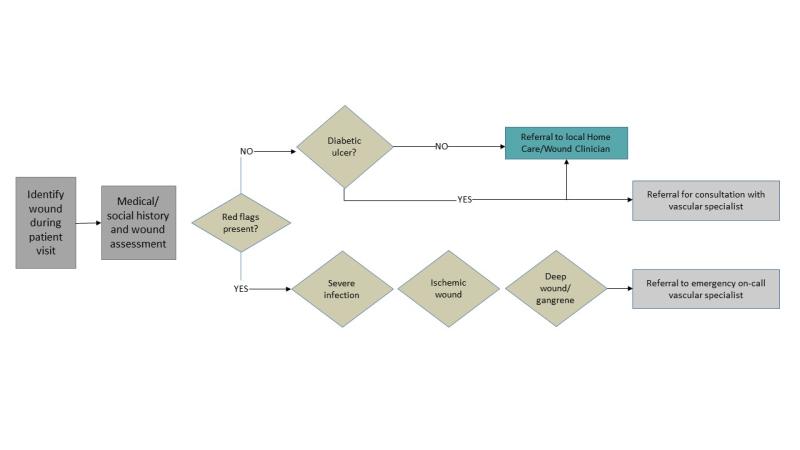Lower Extremity Wound Pathway - Provider Information
The Lower Extremity Wound Pathway addresses identification, assessment and management of patients with common chronic leg and foot wounds including venous stasis ulcers, arterial ulcers, and diabetic foot ulcers.
The purpose of the pathway is to support early, optimal wound management involving primary care providers, specialists and home care teams. Expected results are shorter healing times and reduced incidence of hospitalization and amputation.
Pathway triage
The Lower Extremity Wound Pathway recommends three plans of care:
- Red flags are present: Urgent referral to on-call specialist and/or send to nearest ER. Red flags include significant ischemia, systemic infection, or a deep, gangrenous wound.
- Diabetic ulcer: Referral to vascular specialist for assessment. Referral to home care can be made at the same time for initiation of treatment.
- Venous stasis ulcer: Referral to regional homecare for treatment as per protocol.
Referral form
The Lower Extremity Wound (LEW) Pathway referral form can be sent to regional homecare or to a vascular specialist, or both (in the case of diabetic ulcers). Regional homecare will provide timely feedback to referring providers using the pathway communications form.
Related documents
Treatment protocols
The Lower Extremity Wound Pathway provides treatment protocols based on best practice guidelines. These protocols allow community nurses to initiate standardized care upon receipt of a physician/NP referral. Protocols also encourage consistent care across regions and providers, and facilitate tracking of wound progress.
Related documents
Podiatry and orthotics services
Early foot changes can often be accommodated with ordinary good-quality athletic shoes or orthopedic shoes. Patients on social services can receive an additional allowance for appropriate footwear with a physician prescription. Some private insurance plans cover orthopedic shoes with a physician prescription.
Patients with more involved foot changes may be referred to podiatry or shoe specialists.
Podiatry consult fees are billed fully to patients unless they are covered by Supplementary Health Benefits (for patients receiving social assistance) or Non-Insured Health Benefits (for registered First Nations persons.)
Orthotic programs
- Saskatoon and Prince Albert - Saskatchewan Abilities Council
Phone: 306-374-4400 - Regina - Wascana Rehabilitation Centre
Phone: 306-766-5730 or 306-766-5731
Private professionals
- Podiatrists – find at www.saskpodiatry.org
- Pedorthists – find at www.cpedcs.ca
- Orthotists – find at www.opcanada.ca
Related documents
Continuing education
- Introduction to Lower Extremity Wound Pathway Tools and Forms
Download the PDF below or view the module online. This online module provides a brief overview to assist with orientation of members of wound care teams. - Practical Management of Lower Extremity Wounds
Online CME program created by clinical leaders of the Saskatchewan Lower Extremity Wound Pathway and hosted by the Saskatchewan Ministry of Health. This self-learning program provides a useful update on venous leg ulcers and diabetic foot ulcers - chronic lower extremity wounds that can take many hours of provider time and have a deleterious effect on patient health and quality of life. The course focuses on the role of the physician in early identification of wounds and high-risk legs and feet, as well as coordination of wound management using resources available in Saskatchewan communities. It provides an introduction to tools created by the Pathway based on evidence-informed guidelines.
This program is accredited up to 3 Mainpro+ credits (self-learning). Learners will advance at their own speed through presentation slides with optional video clips and interactive quizzes. Documents to support clinical care, appropriate referral, nursing orders, and patient education are available for download. Browse the course or register on-line at www.woundpathwaysk.ca.


